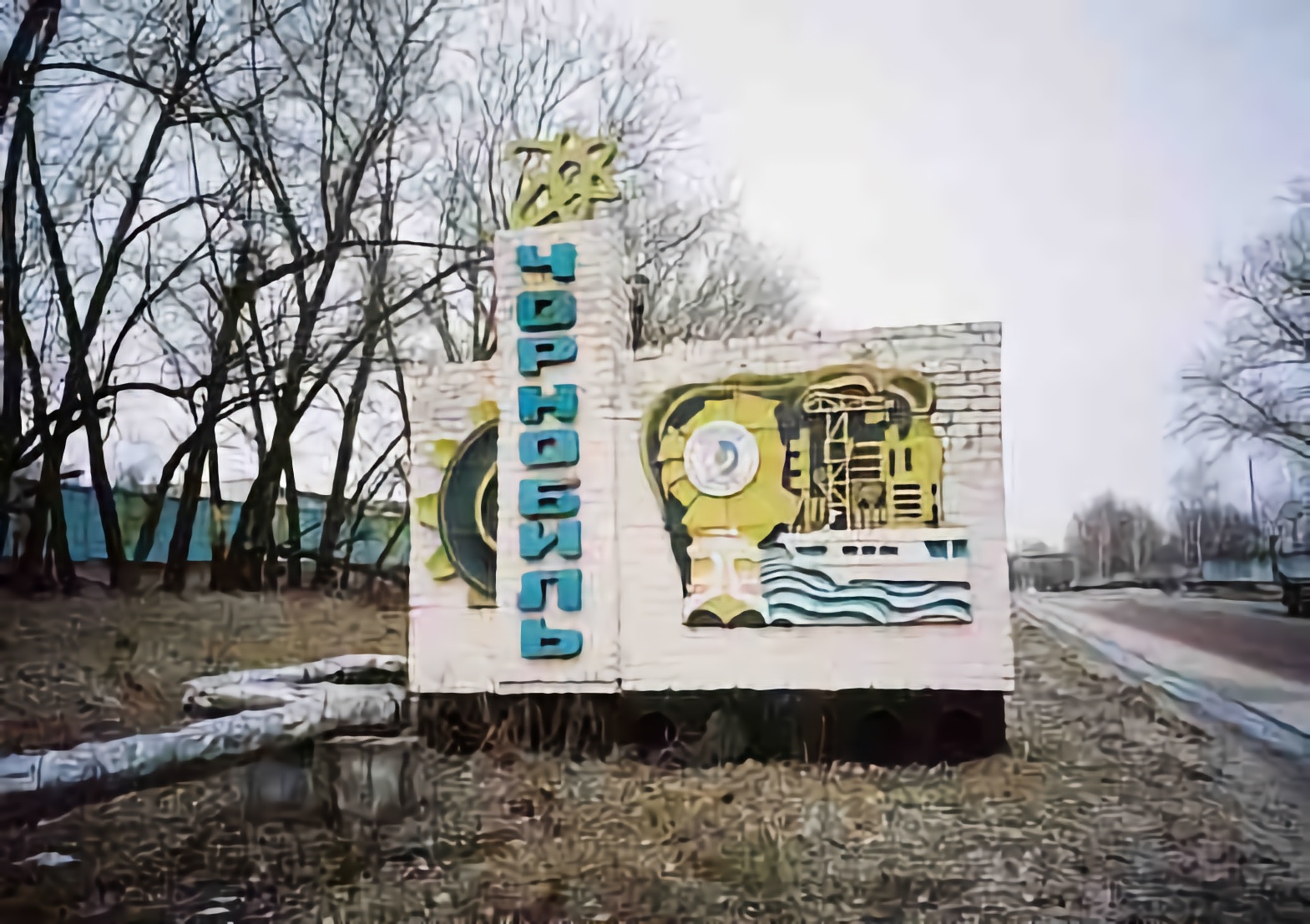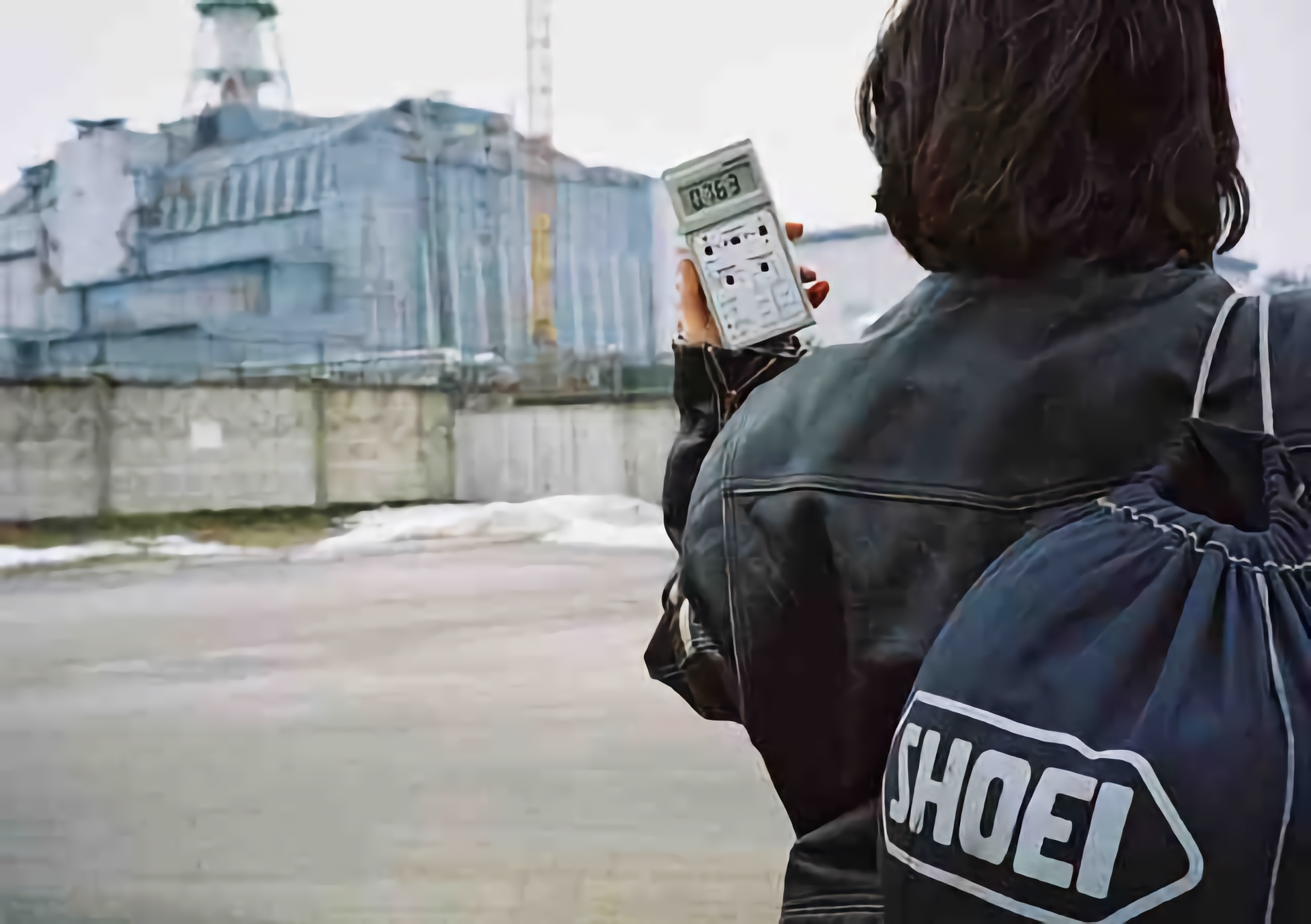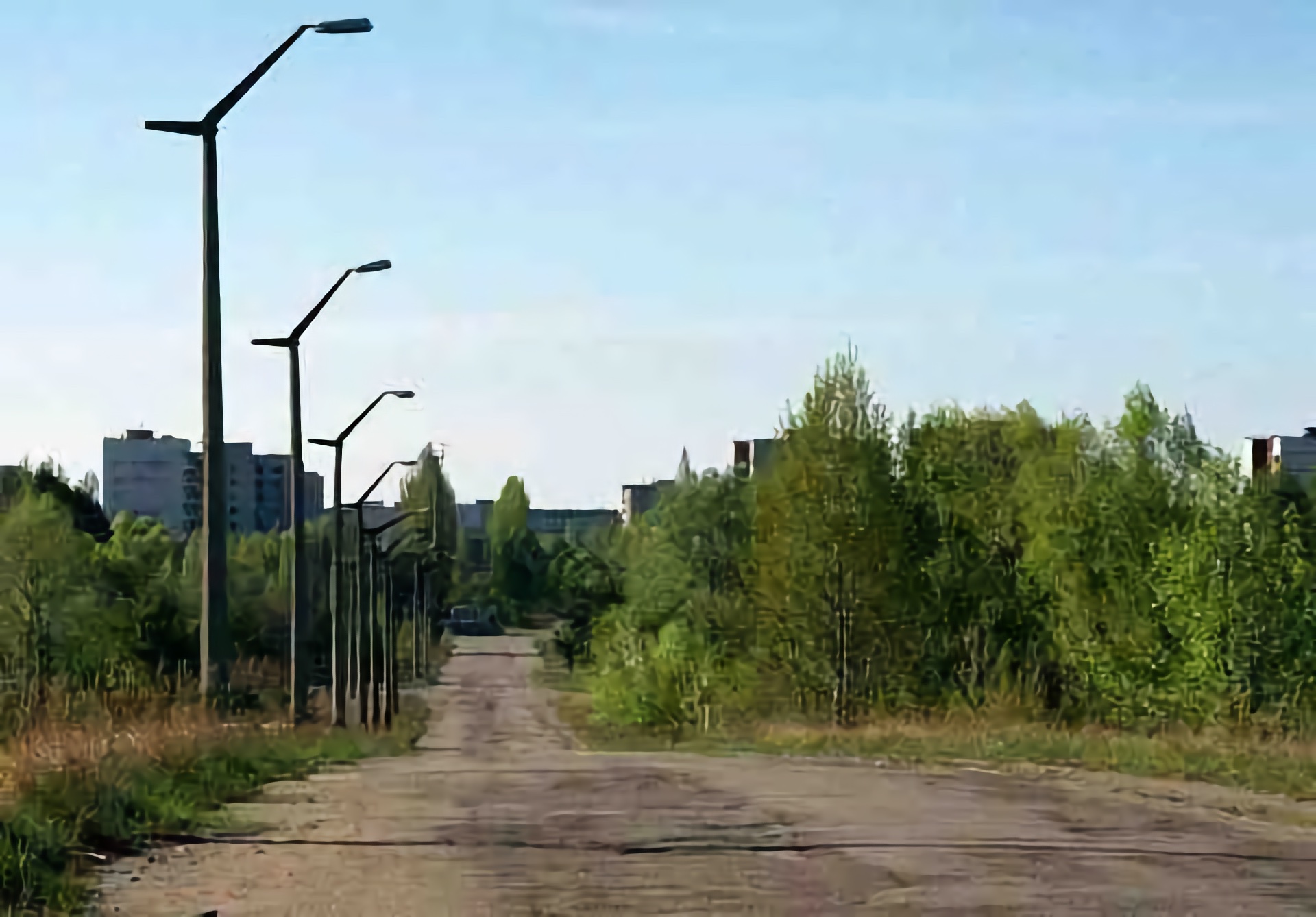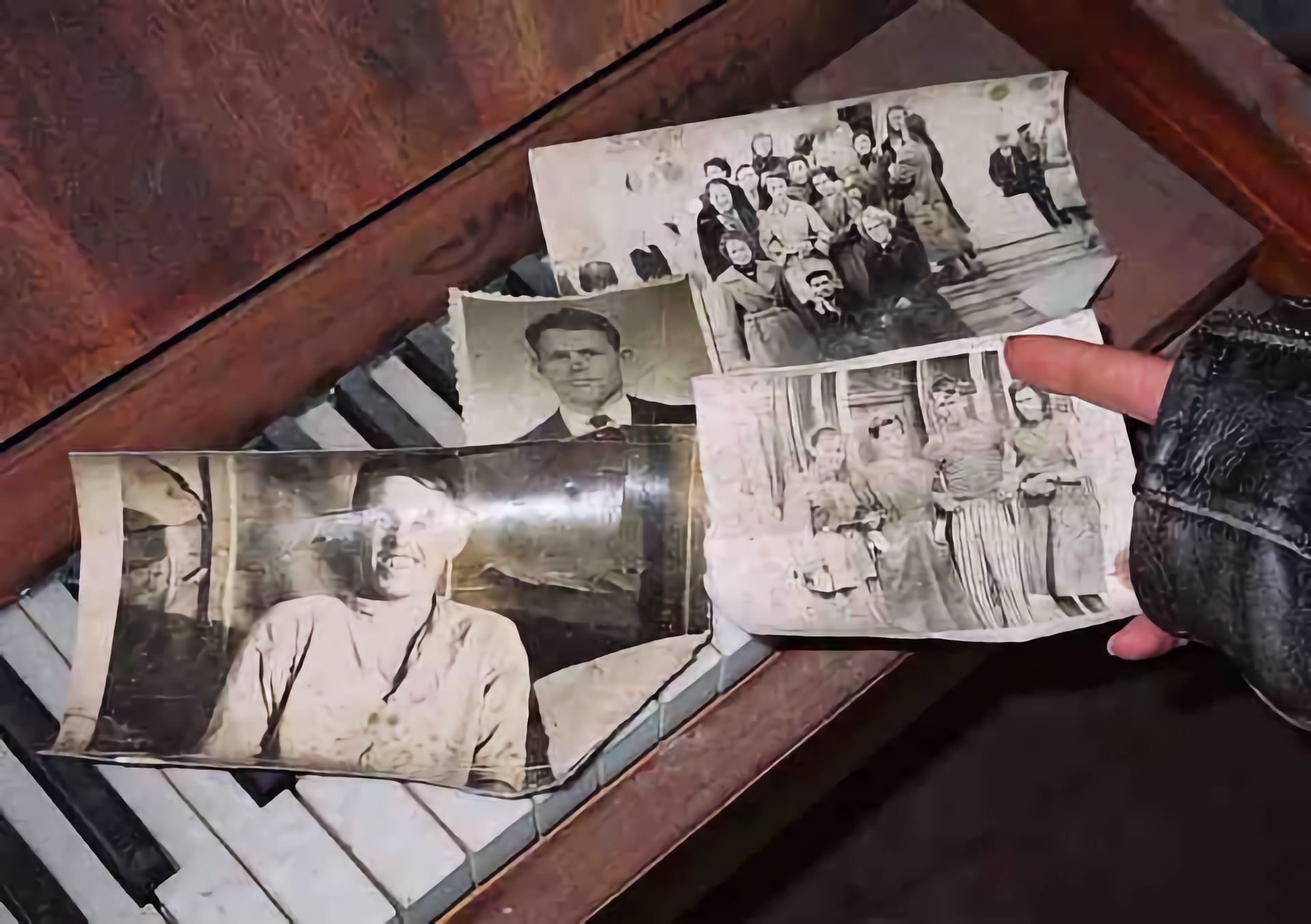update: there’s more pictures, even some video, and a bundle more nuclear and Chernobyl-related stories.
I almost fell into a trap that has snared quite a few before me. bookofjoe recently pointed to the story of Elena, a motorcycle riding woman who claimed to brave the radiation to tour the area around Chernobyl, the nucluear reactor that exploded disasterously in 1986. A commentor quickly pointed out that her story has some history and is surrounded by controversy. The site has been changed a few times, removing many of the bits that seemed most eggregiously wrong to informed readers, but still failing to earn their approval.
The Real Tour
Tours start in Kieve at 8am, from which busses drive two hours north into the “exclusion zone.”
By 10am:
Pass the checkpoint “Dytyatky” and enter the “exclusion zone.” Visit to the site of Chernobyl Nuclear Power Plant – an enterprise once employed more than 5000 staff. Observe object “Sarcophagus” — concrete-and-steel shelter covering radioactive masses and debris left after the explosion. Experience the peace and quiet of the ghost-town Prypyat — all 47.500 inhabitants had to abandon their homes the next day after the accident. Explore the deserted apartment blocks, schools, hotels, kindergardens.
Lunch is at 1pm, followed by…
A briefing conducted by a specialist of the governmental agency “Chernobylinterinform”. Get answers to your questions about the accident, current ecological situation and the future of the exclusion zone.
At 2pm:
Visit to the site of contaminated vehicles. Thousands of tracks, helicopters, armoured personnel vehicles are so soaked with radiation that it is dangerous to approach. Visiting Opachichi and Kupovate villages. Meet the self-settlers, elderly people living in the exclusion zone.
Busses leave for Kieve at 4pm.
It turns ot that Elena is most likely Lena Filatova, and her pictures and story are from an organized bus tour of Chernobyl. One critic, Tony Brown, writes that he met Rimma Kiselytsia, Elena’s tour guide, during his April 27, 2004 tour. Brown reports Rimma’s criticisms as such:
Her father is NOT a scientist. She does NOT have an ‘unlimited access’ pass to Chernobyl.
She has never been on a motorcycle inside Chernobyl. If you notice, the pictures including her bike stop when she gets to the access control point. They did NOT let her in.
While she HAS been to Chernobyl, she did exactly the same tour I did, and she went with her husband.
Brown tells stories of staged shots and moved artifacts. He repeats Rimma’s complaint:
…they seemed to be trying to take photos for shock value — not how the place really is.
…Rimma is very annoyed about the whole affair — she’s getting phone calls from movie producers wanting to make movies about this “heroic” girl. She’s getting people demanding the same unlimited access pass that Elena supposedly has. These do not exist, and she’s sick of explaining it to people.
Brown has a 360° panorama from Prypyat that he took on his tour. His site stands unfinished at chernobylholiday.com.
David McMillan at the University of Manitoba has posted pictures of the area during the years 1994 through 1998. More pictures of Pripiat can be found at pripiat.com. It would seem that official information about Chernobyl comes from Chernobyl.info: “the international communications platform on the longterm consequences of the Chernobyl disaster.”
In many ways, this is no different from many other travelogues. In television celebrity journeys, such as Michael Palin travelling around the world, we suspend disbelief. Obviously such trips are engineered, stage-managed so that Palin is in no danger and invariably encounters interesting people and situations. But there’s a fuzzy line between entertaining fictionalisation and dishonest portrayal; on balance, I think Elena’s account has drifted across it.
I mostly side with the critics, but I never saw the original version of the web site, in its most innacurate or deceptive form. I found it a few days ago. Other sites offer pictures, the Elena story gives a narrative, and while the critics argue with her details of travel in the area, her descriptions of what she encountered are generally accepted. Most of the information is common knowledge, but her telling reminds us of the tragedy. What follows is my edit of her story. Pulling out the bits that are contested, reorganizing the bits that are interesting.
What about the radiation?
To begin our journey, we must learn a little something about radiation. It is really very simple, and the device we use for measuring radiation levels is called a geiger counter . If you flick it on in Kiev, it will measure about 12-16 microroentgen per hour. In a typical city of Russia and America, it will read 10-12 microroentgen per hour.
1,000 microroentgens equal one milliroentgen and 1,000 milliroentgens equal 1 roentgen. So one roentgen is 100,000 times the average radiation of a typical city. A dose of 500 roentgens within 5 hours is fatal to humans. Interestingly, it takes about 2 1/2 times that dosage to kill a chicken and over 100 times that to kill a cockroach.
This sort of radiation level cannot be found in Chernobyl now. In the first days after explosion, some places around the reactor were emitting 3,000-30,000 roentgens per hour. The firemen who were sent to put out the reactor fire were fried on the spot by gamma radiation. The remains of the reactor were entombed within an enormous steel and concrete sarcophagus, so it is now relatively safe to travel to the area.
What happened here?
On the Friday evening of April 25, 1986, the reactor crew at Chernobyl-4, prepared to run a test…

What followed was a combination of the effects of human error on poorly designed, unforgiving technology. The test went wrong in ways the operators never expected or intended. The uranium was allowed to react uncontrollably, causing a steam explosion that blew the reactor containment structure. A further explosion ignited the graphite control rods.
Once graphite starts to burn, its almost impossible to extinguish. It took 9 days and 5000 tons of sand, boron, dolomite, clay and lead dropped from helicopters to put it out. The radiation was so intense that many of those brave pilots died.
The smoke and steam from the fire released radioactive material into the atmosphere and spread it far beyond the towns and farms of Chernobyl.
The Communist government that was in power then kept silent about this accident. In Kiev, they forced people to take part in their preciously stupid labor day parade and it was then that ordinary people began hearing the news of the accident from foreign radio stations and relatives of those who died. The real panic began 7-10 days after accident. Those who were exposed to the exceedingly high levels of nuclear radiation in the first 10 days when it was still a state secret, including unsuspecting visitors to the area, either died or have serious health problems.
The government had few plans to deal with a disaster such as this.
In keeping with a long tradition of Soviet justice, they imprisoned all the people who worked on that shift – regardless of their guilt. The man who tried to stop the chain reaction in a last desperate attempt to avoid the meltdown was sentenced to 14 years in prison. He died 3 weeks later.
50 kilometers west of the reactor, Elena comes across a farmer in a horse-drawn cart.
3.500 people […] either refused to leave or returned to their villages after the meltdown in 1986. I admire those people, because each of them is a philosopher in their own way. When you ask if they are afraid, they say that they would rather die at home from radiation, than die in an unfamiliar place of home-sickness. They eat food from their own gardens, drink the milk of their cows and claim that they are healthy…but the old man is one of only 400 that have survived this long. He may soon join his 3,100 neighbors that rest eternally in the earth of their beloved homes. It appears that the people with the most courage were the first to die here. Maybe that is true everywhere.

Checkpoint
Checkpoints block the roads into the “exclusion zone” surrounding the reactor. The towns and roads outside this area remain accessible, even if largely abandoned. While earlier pictures showed Elana on a motorcycle, no picture inside the zone does.
As I pass through the check point, I feel that I have entered an unreal world. In the dead zone, the silence of the villages, roads, and woods seem to tell something at me…something that I strain to hear…something that attracts and repels me both at the same time. It is divinely eerie – like stepping into that Salvador Dali painting with the dripping clocks.
Trucks and equipment are everywhere, left to rust and nuclear decay where they stopped.
The fire engines never returned in their garages, and the firemen never returned to their homes.
These fire engines are some of the most radioactive objects in all of Chernobyl. The firemen were the first on the scene, and they thought it was an ordinary fire. No one told them, what they were really dealing with.
Much of the equipment was used to respond to the initial emergency or in the government’s hasty cleanup efforts.
The Liquidators are those people who were recruited or forced to assist in the cleanup or the “liquidation” of the consequences of the accident.
As a totalitarian government the Soviet Union forced many young soldiers to assist in the cleanup of the Chernobyl accident, apparently without sufficient protective clothing and insufficient explanation of the danger involved.
Over 650,000 liquidators helped in the cleanup of the Chernobyl disaster in the first year. Many of those who worked as liquidators became ill and according to some estimates about 8,000 to 10,000 have died from the radioactive dose they received at the Chornobyl Power Plant. This group apparently includes those who built the containment building over the destroyed reactor No. 4 which is called the sarcophogas.

Traveling north, a few kilometers from ground zero, the reactor can be seen looming beyond a stand of trees.
The patch of trees […] is called red — or ‘magic’ wood. In 1986, this wood glowed red with radiation. They cut them down and buried them under 1 meter of earth.
The original plant had four reactors. The explosion in one damaged another irreparably, but left the other two operable. The plant continued on those two reactors for fourteen more years, until it was finally shut down for good in 2000. The sarcophagus, however, is disintegrating due to its hasty construction and the effects of radiation.
Four kilometers north of the reactor stands Pripyat, Elena’s “ghost town.”
It was founded in 1970…. 48,000 people lived here and loved their town. In 1986, it was a modern, green and cozy place to live.

At first glance, Ghost Town seems like a normal town. There is a taxi stop, a grocery store, someone’s wash hangs from the balcony and the windows are open.
But then I see a slogan on a building that says – “The Party of Lenin Will Lead Us To The Triumph Of Communism” …and I realize that those windows were opened to the spring air of April of 1986.
Elena finds signs of abandoned lives at every turn. Posters for the Labor Day parade fill a room in a government building.
May 1st never came in this town. On the day of the disaster, the North wind brought the first clouds here and it is said that people ran for their lives as they searched for their children in the atomic smoke. On April 27th, the whole population was evacuated and this street has not seen a parade since…and probably never will again.
Children had to part with their favourite toys. People had to leave everything, from photos of their grandparents to cars. …People had homes, motorcycles, garages, cars, country houses, they had money, friends and relatives. People had their lives. Each had their own niche. And then in a matter of hours , their entire world fell to pieces.

After a few hours trip in an army vehicle, they stood under a shower, washing away radiation. Then they stepped in a new life, naked with no home, no friends, no money, no past and with a very doubtful future.
Viewing danger…
Standing on the roof of the highest building in this empty town brings a feeling of being completely alone in the world – like this whole town is. On the day of disaster, many people gathered on this roof to see the beautiful shining cloud above the Atomic Power Plant.
Elsewhere…
The day after the accident, this place on the bridge provided a good view of the gaping crack in the nuclear containment vessel that was ruptured by the explosion. Many curious people came here to have a look and were bathed in a flood of deadly x-rays emanating directly from the glowing nuclear core.
Epilogue
While Chernobyl is the most remarkable of nuclear accidents, it’s only one of many. Our interest in it goes beyond the tragedy, however. Ray Girvan reminds us that
there’s something intensively evocative about these images. I find it a bit unsettling that the scale of human disaster here is so easy to forget, and one responds instead to the aesthetics of these wistful empty landscapes. Perhaps it’s evoking a back-to-nature romanticism that’s strongly rooted in Western literary tradition. David Platt’s Where London Stood explores why abandoned/ruined cities evoke such emotion, and even a nostalgia, as evident in the Web’s fascination with urban ruins.
Elena’s followup to the Chernobyl tour is The Serpent’s Wall, the site of the German army’s offensive against Kiev. I’ve not seen reports of factual errors or gross deception about that site, but prudence requires readers treat it carefully.
Update
a lot of people are searching for coordinates to Chernobyl. Here’s a street map of the region via MultiMap.com and here’s Google Map’s satellite photo of the reactor. The approximate decimal latitude and longitude are lat=51.388550, lon=30.111465.